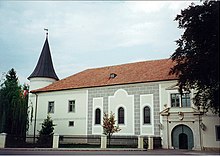Trumau Castle

The Trumau Castle is a moated castle in Trumau in Lower Austria. From the beginning, with a few interruptions, it has been owned by the Cistercian Abbey of Heiligenkreuz .
history
The Trumau estate was donated to the monastery under Abbot Gottschalk by the Babenberg Margrave Leopold IV . The civilian population was resettled according to the rules of the order and the Cistercians built a grangie , a fortified manor. In addition to agriculture and viticulture, sheep were raised. It also had its own mill.
Only in 1462 it came into the possession of the mercenary leader Georg von Pottendorf, who was on the side of Albrecht VI. against his brother Emperor Friedrich III. fought. As early as 1468, however, the property was taken from him by the Bohemian mercenary leader Hinko von Feinfalt. The village of Trumau slowly re-emerged around the estate.
In 1529 at the time of the first Turkish siege there were seven houses in the village. The estate itself was destroyed in 1548. After major reconstructions and alterations, the building was again burned down under Gábor Bethlen in 1621.
In 1650, Abbot Michael Schnabel began to expand the estate into a castle. The construction was completed in 1667. The abbots used the castle for summer stays. But more frequent visits by Emperor Leopold I are also reported.
Although it should have been relatively well fortified this time, it was heavily devastated during the second Turkish invasion in 1683 . During the reconstruction, towers were built lower than originally. The castle was also rebuilt after the fires in 1811 and 1880. In relation to earlier phenomena, however, it must have lost a lot.
In the post-war period , the Soviet occupying forces set up a communications center from 1945 to 1947, which caused the building to suffer badly. Partitions were torn down. The bulk floor was used as a ballroom. For this purpose, the false ceiling was removed.
The last restorations took place between 1993 and 1995. A museum was set up in 1999, which has since ceased to exist, where prehistoric finds were also shown that were found in the course of the construction of the southern motorway .
In 2009 the International Theological Institute for Studies on Marriage and Family moved to the castle. Until then, this institute was located in the Kartause Gaming .
construction
The two-story building is almost square. At three corners there are round towers with conical roofs. The original moat could be overcome via a drawbridge .
The oldest part is the north wing, the ground floor of which goes back to the original building from the 12th century.
In the spacious chapel there was an altarpiece that was painted by Johann Michael Rottmayr in 1702. However, this was stolen in 1945. The picture was made in 1950 from a copy of a Coronation of Mary by Martino Altomonte , which was painted by Alice Rougon. The chapel is now Byzantine (Greek-Catholic) and is ecumenically entrusted by the parish Trumau and the Greek-Catholic central parish St. Barbara in Vienna.
The old Meierhof from 1638 stands southeast of the castle. This was restored after a fire in 1880.
The courtyard is freely accessible.
literature
- Georg Dehio (greeting), Peter Aichinger-Rosenberger (editing): Lower Austria south of the Danube ( Handbook of Art Monuments Austria ). Verlag Berger, Vienna 2003, ISBN 3-85028-365-8 (2 vols .; here especially vol. 2).
- Felix Halmer: Castles and palaces between Baden, Gutenstein and Wr. Neustadt . Vienna: Birken-Verlag 1968 (Lower Austria / 1; Vol. 2).
- Georg C. Martinic: Austrian Castle Lexicon . Linz: Landesverlag 1992, ISBN 3-85214-559-7 .
- Gerhard Stenzel: From castle to castle in Austria . Vienna: Kremayer & Scheriau 1976, ISBN 3-218-00288-5 .
Web links
- Entry via Trumau Castle to Burgen-Austria
- Trumau Castle on Burgenkunde.at
Individual evidence
- ↑ Werner Richter, head of the building department in Heiligenkreuz Abbey: Use of Kaiserstein in Trumau Abbey and Castle
Coordinates: 47 ° 59 ′ 33.6 ″ N , 16 ° 20 ′ 17.7 ″ E
